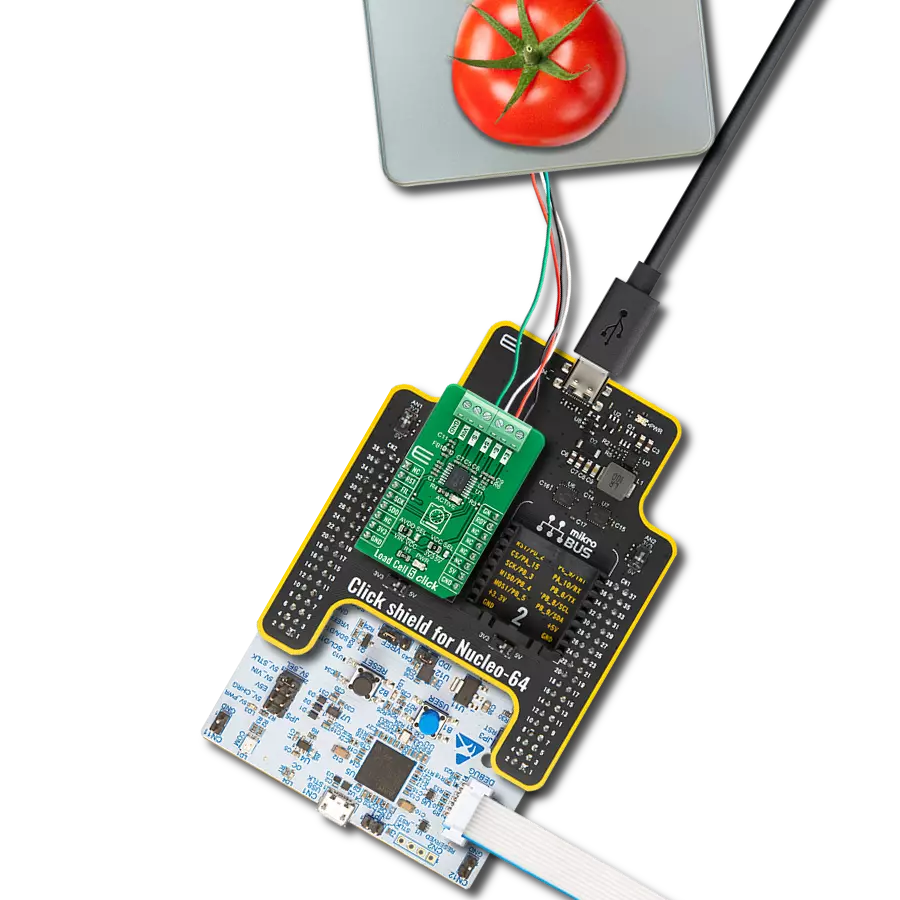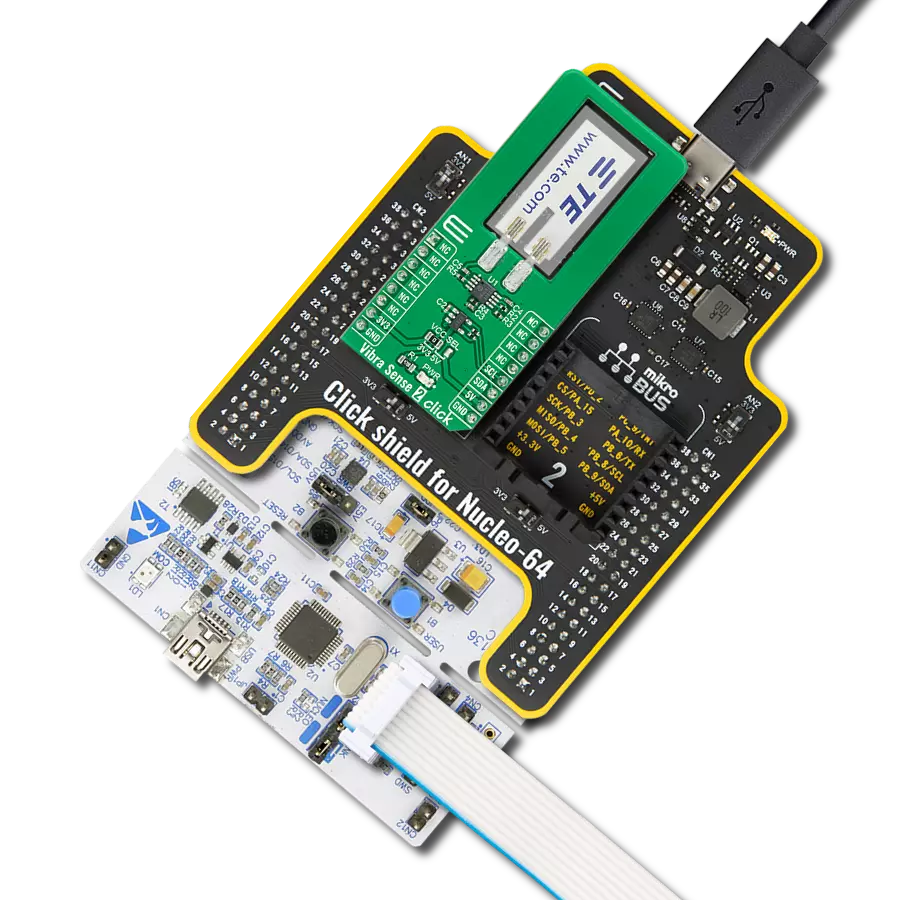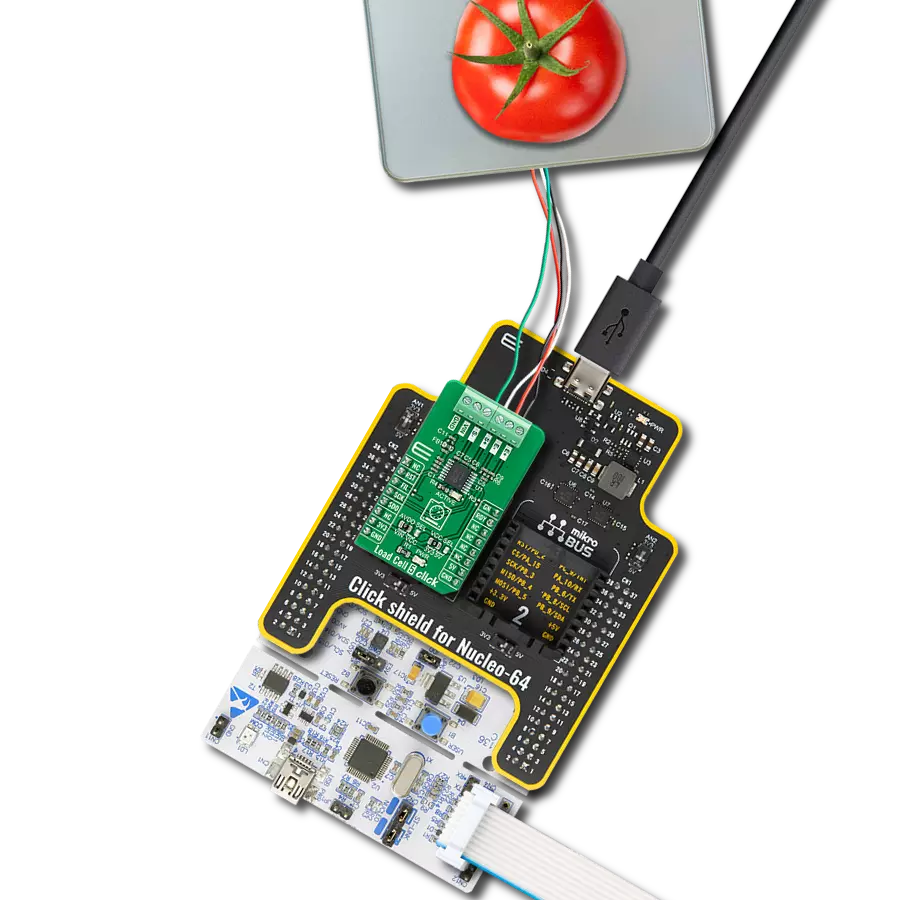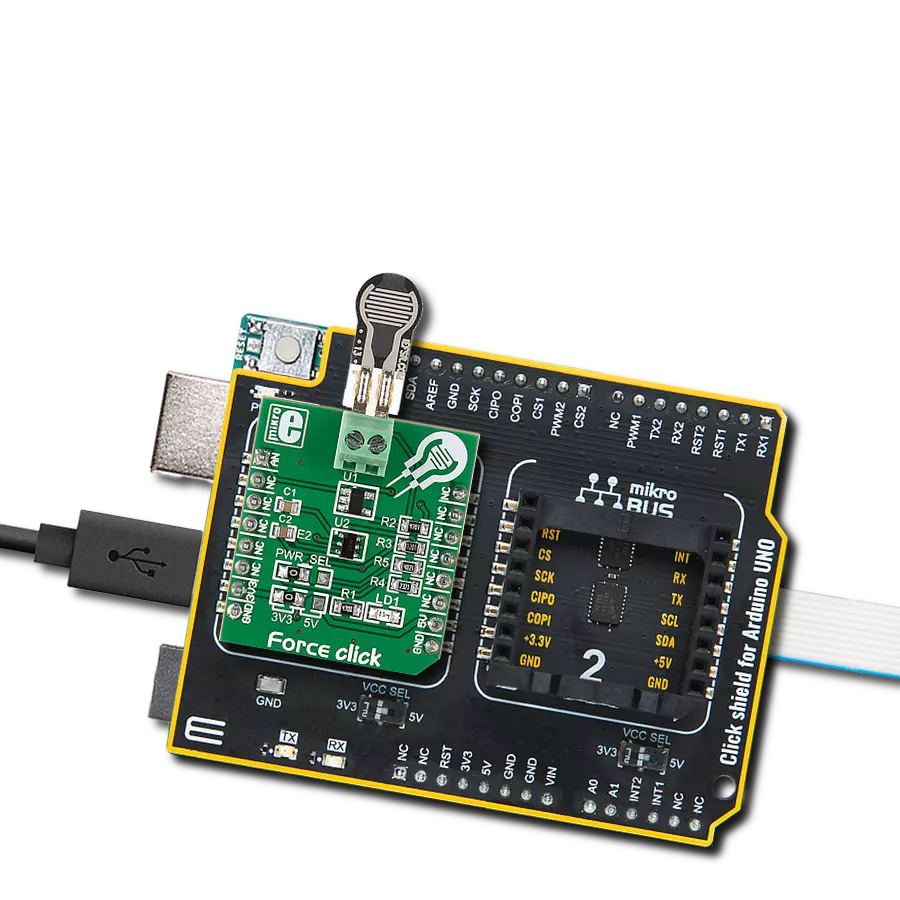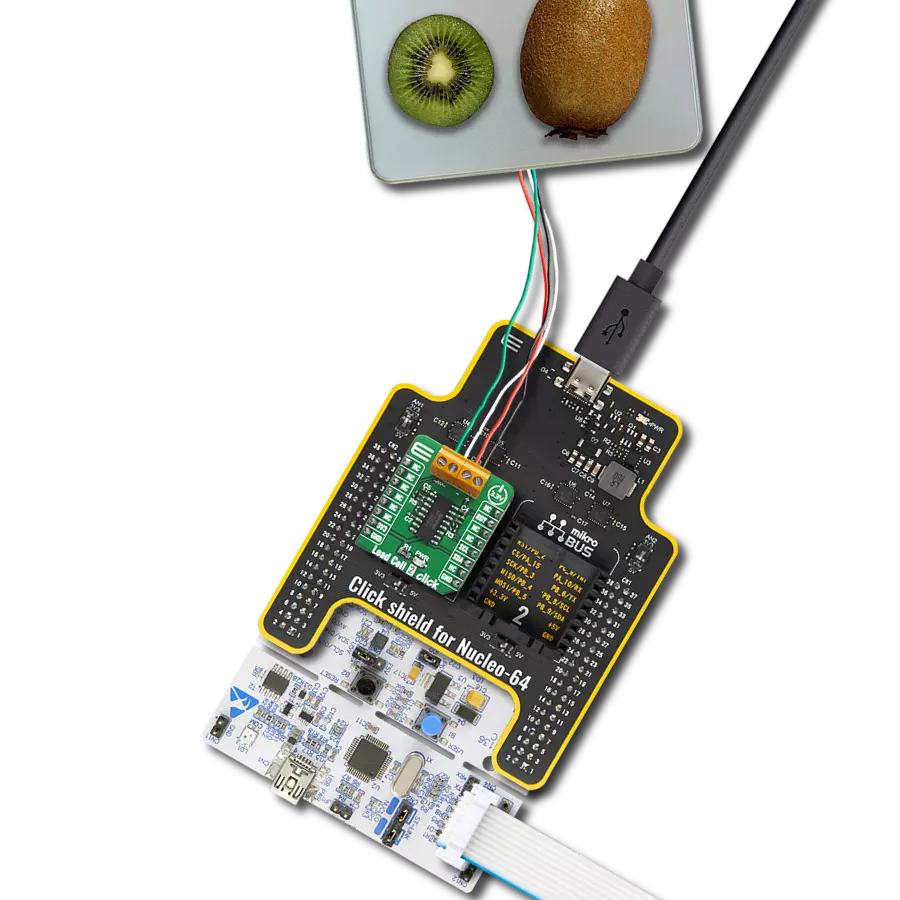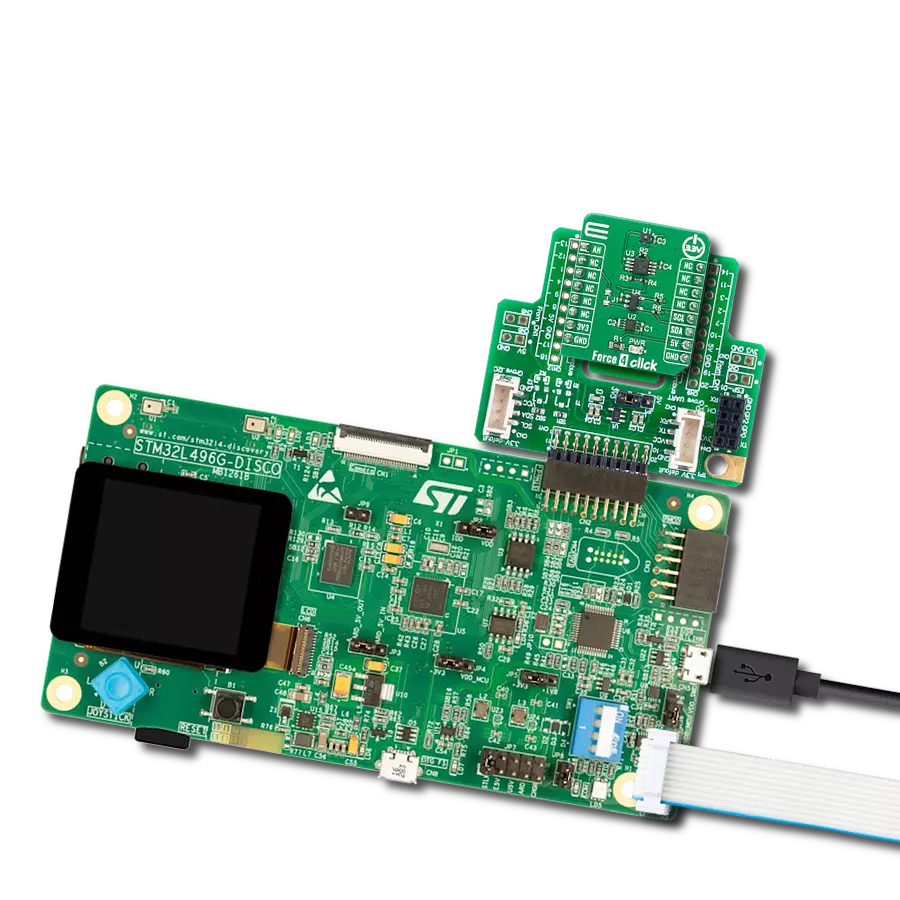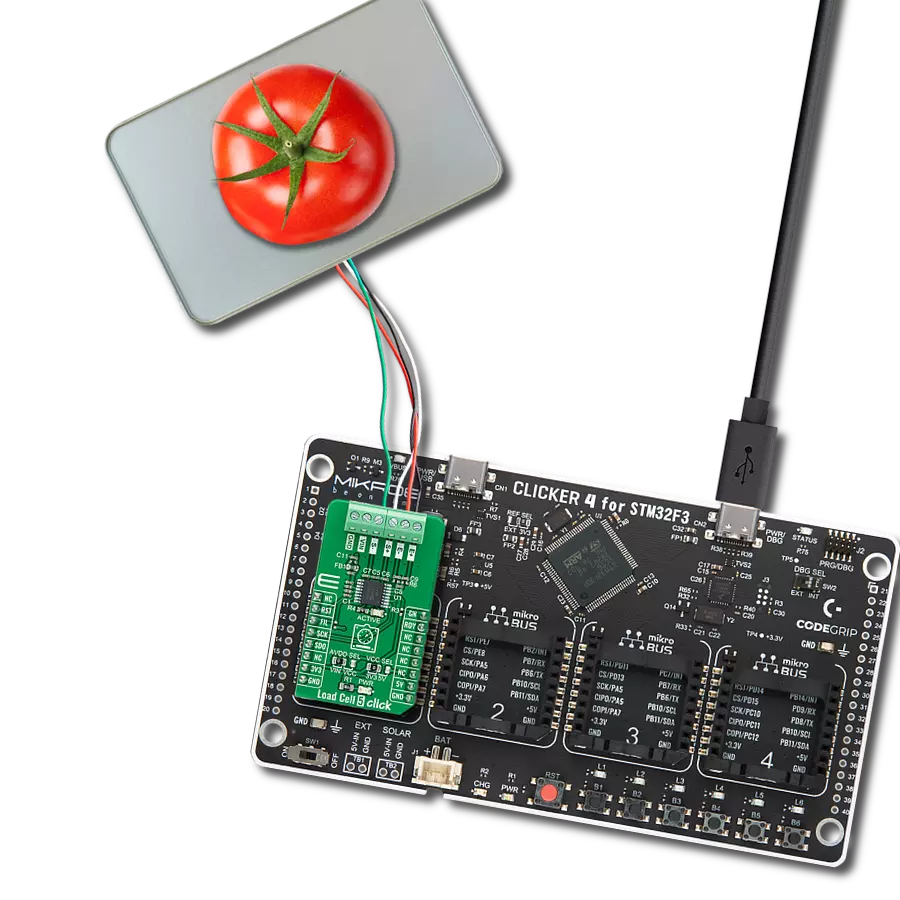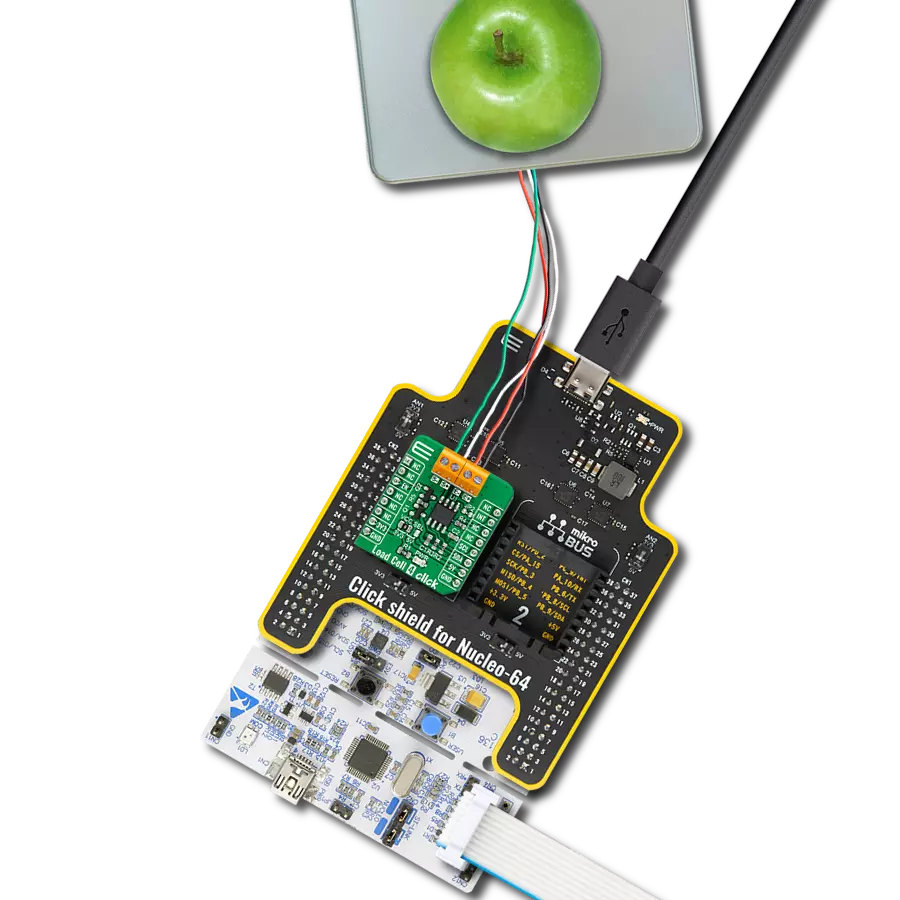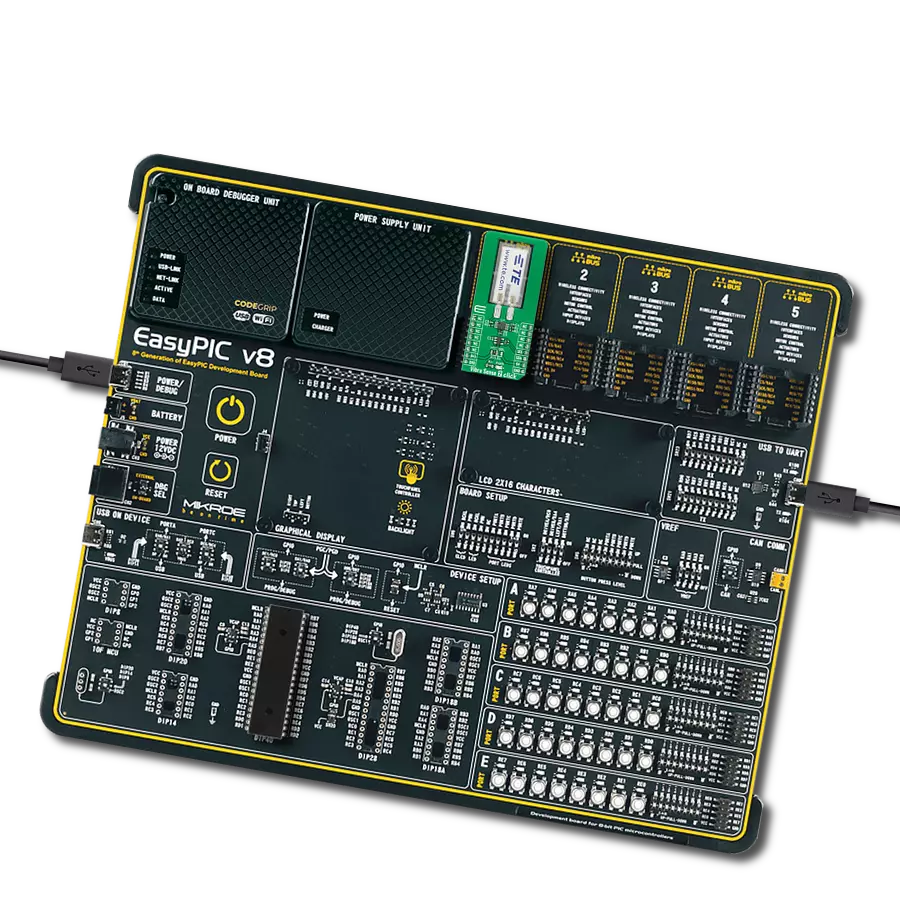Enhance equipment reliability with our piezo vibro sensor to monitor and analyze mechanical vibrations, enabling proactive maintenance
A
A
Hardware Overview
How does it work?
Vibra Sense 2 Click is based on the LDT0-028K, a flexible 28 μm thick piezoelectric PVDF polymer film with screen-printed silver ink electrodes, laminated to a 0.125 mm polyester substrate, and fitted with two crimped contacts from TE Connectivity. This piezo sensor comes with solderable crimp pins often used for flex, touch, vibration, and shock measurements. When the sensor moves back and forth, the voltage comparator inside will create a small AC and a large voltage. However, it has a high receptivity for strong impacts with a wide dynamic range that guarantees excellent measuring performance. The LDTM-028K is a vibration sensor where the sensing element comprises a cantilever beam loaded by an additional mass to offer high
sensitivity at low frequencies. A charge amplifier detects the output signal as a vibration and sends it to the single-ended analog input pin of the ADC. Using a charge amplifier allows a very long measurement time constant and thus allows the "open-circuit" voltage response to be calculated). To bring the corresponding signal to the ADC pin, this Click board™ uses an analog circuitry made of OpAmp MCP6282 from Microchip that has a buffer function. Vibra Sense 2 Click communicates with MCU through the MCP3221, a successive approximation A/D converter with a 12-bit resolution from Microchip, using a 2-wire I2C compatible interface. This device provides one single-ended input with low power consumption, a low maximum conversion current, and a
Standby current of 250μA and 1μA, respectively. Data on the I2C bus can be transferred to 100 kbit/s in the Standard Mode and 400 kbit/s in the Fast Mode. Also, maximum sample rates of 22.3 kSPS with the MCP3221 are possible in a Continuous-Conversion Mode with a clock rate of 400 kHz. This Click board™ can operate with either 3.3V or 5V logic voltage levels selected via the VCC SEL jumper. This way, both 3.3V and 5V capable MCUs can use the communication lines properly. Also, this Click board™ comes equipped with a library containing easy-to-use functions and an example code that can be used as a reference for further development.
Features overview
Development board
Nucleo-64 with STM32L073RZ MCU offers a cost-effective and adaptable platform for developers to explore new ideas and prototype their designs. This board harnesses the versatility of the STM32 microcontroller, enabling users to select the optimal balance of performance and power consumption for their projects. It accommodates the STM32 microcontroller in the LQFP64 package and includes essential components such as a user LED, which doubles as an ARDUINO® signal, alongside user and reset push-buttons, and a 32.768kHz crystal oscillator for precise timing operations. Designed with expansion and flexibility in mind, the Nucleo-64 board features an ARDUINO® Uno V3 expansion connector and ST morpho extension pin
headers, granting complete access to the STM32's I/Os for comprehensive project integration. Power supply options are adaptable, supporting ST-LINK USB VBUS or external power sources, ensuring adaptability in various development environments. The board also has an on-board ST-LINK debugger/programmer with USB re-enumeration capability, simplifying the programming and debugging process. Moreover, the board is designed to simplify advanced development with its external SMPS for efficient Vcore logic supply, support for USB Device full speed or USB SNK/UFP full speed, and built-in cryptographic features, enhancing both the power efficiency and security of projects. Additional connectivity is
provided through dedicated connectors for external SMPS experimentation, a USB connector for the ST-LINK, and a MIPI® debug connector, expanding the possibilities for hardware interfacing and experimentation. Developers will find extensive support through comprehensive free software libraries and examples, courtesy of the STM32Cube MCU Package. This, combined with compatibility with a wide array of Integrated Development Environments (IDEs), including IAR Embedded Workbench®, MDK-ARM, and STM32CubeIDE, ensures a smooth and efficient development experience, allowing users to fully leverage the capabilities of the Nucleo-64 board in their projects.
Microcontroller Overview
MCU Card / MCU
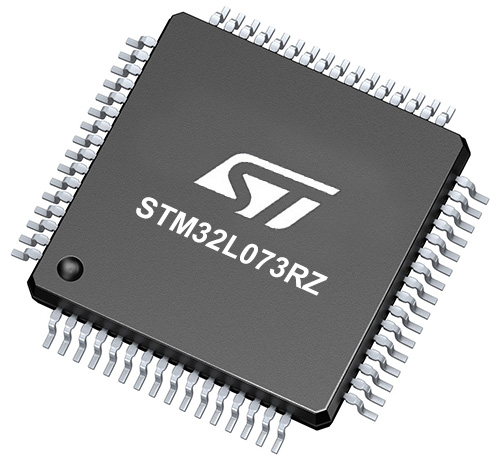
Architecture
ARM Cortex-M0
MCU Memory (KB)
192
Silicon Vendor
STMicroelectronics
Pin count
64
RAM (Bytes)
20480
You complete me!
Accessories
Click Shield for Nucleo-64 comes equipped with two proprietary mikroBUS™ sockets, allowing all the Click board™ devices to be interfaced with the STM32 Nucleo-64 board with no effort. This way, Mikroe allows its users to add any functionality from our ever-growing range of Click boards™, such as WiFi, GSM, GPS, Bluetooth, ZigBee, environmental sensors, LEDs, speech recognition, motor control, movement sensors, and many more. More than 1537 Click boards™, which can be stacked and integrated, are at your disposal. The STM32 Nucleo-64 boards are based on the microcontrollers in 64-pin packages, a 32-bit MCU with an ARM Cortex M4 processor operating at 84MHz, 512Kb Flash, and 96KB SRAM, divided into two regions where the top section represents the ST-Link/V2 debugger and programmer while the bottom section of the board is an actual development board. These boards are controlled and powered conveniently through a USB connection to program and efficiently debug the Nucleo-64 board out of the box, with an additional USB cable connected to the USB mini port on the board. Most of the STM32 microcontroller pins are brought to the IO pins on the left and right edge of the board, which are then connected to two existing mikroBUS™ sockets. This Click Shield also has several switches that perform functions such as selecting the logic levels of analog signals on mikroBUS™ sockets and selecting logic voltage levels of the mikroBUS™ sockets themselves. Besides, the user is offered the possibility of using any Click board™ with the help of existing bidirectional level-shifting voltage translators, regardless of whether the Click board™ operates at a 3.3V or 5V logic voltage level. Once you connect the STM32 Nucleo-64 board with our Click Shield for Nucleo-64, you can access hundreds of Click boards™, working with 3.3V or 5V logic voltage levels.
Used MCU Pins
mikroBUS™ mapper
Take a closer look
Click board™ Schematic

Step by step
Project assembly
Track your results in real time
Application Output
1. Application Output - In Debug mode, the 'Application Output' window enables real-time data monitoring, offering direct insight into execution results. Ensure proper data display by configuring the environment correctly using the provided tutorial.

2. UART Terminal - Use the UART Terminal to monitor data transmission via a USB to UART converter, allowing direct communication between the Click board™ and your development system. Configure the baud rate and other serial settings according to your project's requirements to ensure proper functionality. For step-by-step setup instructions, refer to the provided tutorial.

3. Plot Output - The Plot feature offers a powerful way to visualize real-time sensor data, enabling trend analysis, debugging, and comparison of multiple data points. To set it up correctly, follow the provided tutorial, which includes a step-by-step example of using the Plot feature to display Click board™ readings. To use the Plot feature in your code, use the function: plot(*insert_graph_name*, variable_name);. This is a general format, and it is up to the user to replace 'insert_graph_name' with the actual graph name and 'variable_name' with the parameter to be displayed.

Software Support
Library Description
This library contains API for Vibra Sense 2 Click driver.
Key functions:
vibrasense2_read_data- Read data functionvibrasense2_read_voltage- Read voltage functionvibrasense2_vibration_level- Get Vibration Level function
Open Source
Code example
The complete application code and a ready-to-use project are available through the NECTO Studio Package Manager for direct installation in the NECTO Studio. The application code can also be found on the MIKROE GitHub account.
/*!
* @file main.c
* @brief VibraSense2 Click example
*
* # Description
* This example shows capabilities of Vibra Sense 2 Click board.
*
* The demo application is composed of two sections :
*
* ## Application Init
* Initalizes I2C driver and makes an initial log.
*
* ## Application Task
* Demonstrates use of Vibra Sense 2 Click board by checking
* vibration levels and displaying changes via USART terminal.
*
* @author Stefan Ilic
*
*/
#include "board.h"
#include "log.h"
#include "vibrasense2.h"
static vibrasense2_t vibrasense2;
static log_t logger;
int8_t old_val;
int8_t new_val;
void application_init ( void ) {
log_cfg_t log_cfg; /**< Logger config object. */
vibrasense2_cfg_t vibrasense2_cfg; /**< Click config object. */
/**
* Logger initialization.
* Default baud rate: 115200
* Default log level: LOG_LEVEL_DEBUG
* @note If USB_UART_RX and USB_UART_TX
* are defined as HAL_PIN_NC, you will
* need to define them manually for log to work.
* See @b LOG_MAP_USB_UART macro definition for detailed explanation.
*/
LOG_MAP_USB_UART( log_cfg );
log_init( &logger, &log_cfg );
log_info( &logger, " Application Init " );
// Click initialization.
vibrasense2_cfg_setup( &vibrasense2_cfg );
VIBRASENSE2_MAP_MIKROBUS( vibrasense2_cfg, MIKROBUS_1 );
err_t init_flag = vibrasense2_init( &vibrasense2, &vibrasense2_cfg );
if ( I2C_MASTER_ERROR == init_flag ) {
log_error( &logger, " Application Init Error. " );
log_info( &logger, " Please, run program again... " );
for ( ; ; );
}
old_val = VIBRASENSE2_ERROR;
log_info( &logger, " Application Task " );
log_printf( &logger, "-------------------------------------\r\n" );
}
void application_task ( void ) {
new_val = vibrasense2_vibration_level( &vibrasense2 );
Delay_ms ( 100 );
if ( new_val != old_val ) {
switch ( new_val ) {
case VIBRASENSE2_VIBRA_LVL_0: {
log_printf( &logger, " No Vibration \r\n" );
log_printf( &logger, "-------------------------------------\r\n" );
break;
}
case VIBRASENSE2_VIBRA_LVL_1: {
log_printf( &logger, " Vibration level : Marginal Vibration \r\n" );
log_printf( &logger, "-------------------------------------\r\n" );
break;
}
case VIBRASENSE2_VIBRA_LVL_2: {
log_printf( &logger, " Vibration level : Slight Vibration \r\n" );
log_printf( &logger, "-------------------------------------\r\n" );
break;
}
case VIBRASENSE2_VIBRA_LVL_3: {
log_printf( &logger, " Vibration level : Enhanced Vibration \r\n" );
log_printf( &logger, "-------------------------------------\r\n" );
break;
}
case VIBRASENSE2_VIBRA_LVL_4: {
log_printf( &logger, " Vibration level : Moderate Vibration \r\n" );
log_printf( &logger, "-------------------------------------\r\n" );
break;
}
case VIBRASENSE2_VIBRA_LVL_5: {
log_printf( &logger, " Vibration level : High Vibration \r\n" );
log_printf( &logger, "-------------------------------------\r\n" );
break;
}
case VIBRASENSE2_VIBRA_LVL_6: {
log_printf( &logger, " Vibration level : Severe Vibration \r\n" );
log_printf( &logger, "-------------------------------------\r\n" );
break;
}
default: {
log_printf( &logger, "Error occured!" );
log_printf( &logger, "-------------------------------------\r\n" );
}
}
old_val = new_val;
}
}
int main ( void )
{
/* Do not remove this line or clock might not be set correctly. */
#ifdef PREINIT_SUPPORTED
preinit();
#endif
application_init( );
for ( ; ; )
{
application_task( );
}
return 0;
}
// ------------------------------------------------------------------------ END
Additional Support
Resources
Category:Force



















